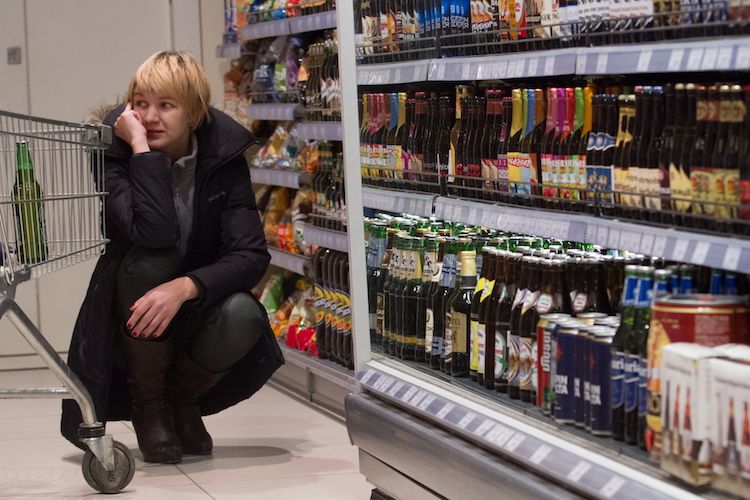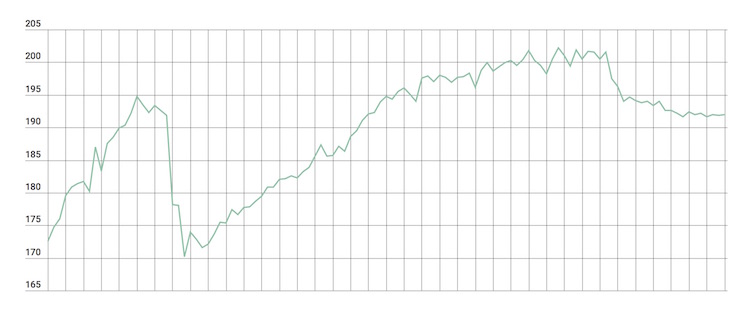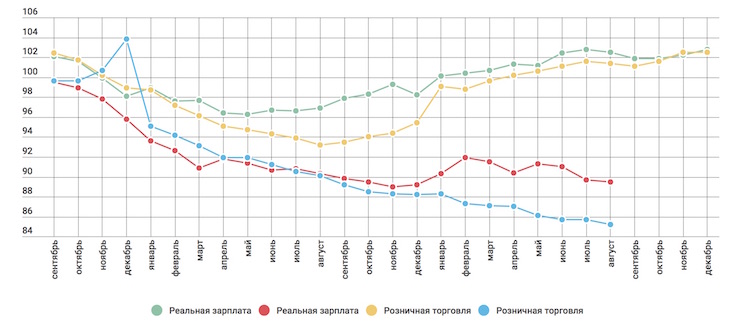In his latest commentary about recent events in the Russian economy, Sergey Aleksashenko, nonresident senior fellow at the Brookings Institution, again analyzes the latest economic statistics and emphasizes that the country’s prospects are not bright. The basic drivers of domestic demand—public consumption and investment—continue to fall steadily, and there are real problems with the Finance Ministry’s plan for reducing the budget deficits.

The increase in wages in the first half of 2016 did not stop the decline in consumption by the population. Photo: Kirill Kukhmar / TASS
The Prospects Are Unclear
As I expected, analysts of the Russian Development Bank (VEB) changed their appraisal of the Russian economy for July of this year—from growth of 0.1 percent to a decline of 0.1 percent. The correction occurred after taking into account complete statistical data for the month—primarily due to wholesale trade. However, their appraisal for August is again positive (0.1 percent growth), although the number and type of reservations in the VEB’s comments makes one doubt the steadiness of such growth.
Look:
- “The demand for investment goods lessened by 20.2 percent…, the volume of production in the machine-building sector lessened substantially, the decline in the processing sector continued…, the lengthy decline in the production of building materials is continuing…, a decline in construction has resurfaced;
- “Retail trade and services, after a lengthy decline in both July and August, began to show positive figures…, however, an increase in consumption thus far is based on a gradual lowering of the population’s tendency to save…;
- “The trend in incomes of the population has significantly worsened…, wages in July and August showed a decline…, the prospects for a further recovery in incomes are so far unclear”;
- “In August, the growth in GDP was mainly based on the very large harvest…, but by the fourth quarter this effect will have worn off. Overall, new factors are not yet noticeable in the domestic demand that could ensure a more stable revival of the economy.”
Chart 1. VEB’s Index – recent evaluation of GDP with seasonal and calendar factors removed (100 = January 1999)

Source: VEB
Excuse the lengthy citation, but it would be impossible to describe the present economic situation more precisely. Just as it would be impossible to draw up an optimistic scenario for the development of the Russian economy over the next few months.
Rosstat has so far not published detailed data that would permit us to determine which drivers of Russian GDP in the second quarter have ensured growth, but from the information we do have, it is apparent that two of the most powerful factors of domestic demand—public consumption and investment—continue to decline steadily.
The upsurge in wages that occurred in the first half of the year in no way influenced the monotonous decline in consumption by the population (the volume of retail trade). A possible reason for the absence of any reaction is the desire of better-off Russians (approximately one-third of all families have at least some savings) to build up some “fat” in anticipation of further worsening of the economic situation. A growth in incomes among this group translates to growing savings and paying down of loan debts, while in lower-income groups, the volume of current consumption remains almost unchanged, since their real income levels are also unchanged.
I am not a prophet and cannot confidently foretell the future, but during the last crisis, consumption reacted to wage increases (which began in June 2009) seven months later (in January 2010). If we supposed that the growth of wages that occurred in the first quarter was a “false start,” then it follows that growth in public consumption should not be expected this year.
Chart 2. Trend in retail turnover and in real wages, seasonally and calendar-adjusted, 2008–-2010 and 2014–2016 (100 = June 2008 = June 2014)

Source: Rosstat. Adjustments: Center for Development of the Higher School of Economics National Research University.
Green: real wages (2008-2010); real wages (2014-2016); yellow: retail turnover (2008-2010); blue: retail turnover (2014-2016).
Matters fare even worse as concerns investment: the peak figures were reached 3.5 years ago, in the first quarter of 2013, and after one and a half years of a saw-toothed pattern they have plunged, dropping overall by 13 percent. In order to appreciate the scale of what has happened, suppose that all this time investment had grown at a rate of 4 percent per year, which would correspond with approximately a 2 percent growth in GDP. Well then, during this time the Russian economy fell short by almost two years’ worth of investment (at 2015 levels). Nonetheless the government claims that growth in the economy is right on the verge of occurring.
Chart 3. Trend in GDP and investments, seasonally and calendar-adjusted

Source: Rosstat. Adjustment: Center for Development of the Higher School of Economics National Research University.
Green: investment; red: GDP.
The Minister Thinks It’s Funny
The lowering of the key rate by the Bank of Russia was fully expected and overdue.
Economic Minister Aleksey Ulyukaev couldn’t help sarcastically quipping about this on the eve of the board of directors’ meeting: “It will be really funny if we don’t do it now.”
Funny or not, through clenched teeth the board of directors of the Central Bank lowered the rate by a symbolic half of one percent, announcing with vengeance that it doesn’t plan to do it again before the end of the year.
There Is No Money Even for the Finance Ministry
“There is no money… You hang in there.” This statement by Prime Minister Dmitry Medvedev, which went viral, has sounded especially harsh recently. It turns out that at this time the Finance Ministry has no money to repay debts—debts that weren’t taken into account as part of the government debt, and which, in fact, were to have been repaid by the Defense Ministry by means of ongoing funding. But they tried their best, you know the rest!
In 2011–2013, when no one wanted to discuss budget difficulties seriously, the Finance Ministry (don’t laugh!) demanded a reduction in the budget deficit and for its sake agreed to a worse-than-dubious form of financing the implementation of defense procurement by means of bank credits. In other words, banks gave credits to defense enterprises under the budget’s guarantee of future expenditures for financing defense procurement. The Finance Ministry never named the total sum of credits and didn’t include them in the makeup of the government debt, but by my estimate, they comprised about two trillion rubles. Apparently, the Finance Ministry never seriously considered retiring these credits, considering them the problem of the Defense Ministry. But nothing is constant.
Beginning this year, financing of defense orders started to decline compared to the initial plans. Western sanctions and the disruption of military and technical cooperation with Ukraine forced the Defense Ministry to alter procurement plans and change its financing priorities. As a result, it seems the programs begun with credited money were not completed, and the Defense Ministry doesn’t have the money to extinguish the loans received by enterprises.
Of course, nothing so bad as the default of 1998 is happening. Without a doubt, the credits will be restructured—to the great delight of the banks that participated in the program, which won’t have to show new bad assets on their balance sheets. But obviously, the varied plans of the government don’t harmonize well with one another, creating numerous breaches in the already-leaky budget ship.
The Finance Ministry Stubbornly Holds Back Expenditures
The Finance Ministry’s joyous statements that the federal budget made it through the summer months with virtually no deficit are no more than wishful thinking. Yes, the deficit was minimal, but it was achieved wholly thanks to holding back on budget expenditures, which were financed at a rate of only 60 percent for the first eight months of the year.
If the Finance Ministry reaches the yearly total volumes by means of evenly distributing expenditures during the remaining four months, then the monthly expenditures must grow by more than 50 percent in comparison with January through August. If this is done (as is traditional) in the last two months of the year, then the amount of monthly expenditures in November and December must almost double.
Non-scary Scarecrows
The Duma elections have taken place, and soon the deputies will gather on Okhotny Ryad and give the appearance of being ready to discuss the budget. I don’t know exactly how much space for maneuver and freedom of expression as deputies the government will leave them, but my guess isn’t much.
The Finance Ministry’s plan consists in freezing the nominal expenditures at this year’s level and reducing the budget deficit, for the most part thanks to the inflationary growth of incomes. No one disputes the idea itself, but apparently there are big difficulties with its implementation: namely with deciding which expenditures can and should be reduced, and by how much.
Indirect evidence of this is the information regularly spun off by the Finance Ministry, which allegedly proposes considering various “alternative versions” of budget policy that do not require such decisive reductions of expenditures in real terms, for example: raising the value added tax (VAT) and income tax; federalizing part of the tax on profits that goes into the regional budgets; further tax maneuvers in the oil sector (which always end up benefiting the treasury); and threatening to take 170 billion rubles from Gazprom. Of course, the majority of these proposals—at least those concerning raising taxes, and at least with regard to 2017—don’t stand any chance of being realized, but obviously, that’s not why they are voiced and “leaked” to the press.
It is understandable that a solution to the budget quandary must be conveyed by Vladimir Putin, the person wanting to receive maximum support in the national referendum in a year and a half. On the one hand, the Duma elections showed that the population regards what happens in the economy quite apathetically, and doesn’t see a direct link between the decline in its standard of living and who makes the decisions in the country. On the other hand, the established system of barriers guarantees the absence of any serious opponent to Putin whatsoever in the upcoming presidential elections. And one would think it should be possible for him to “keep cool” and support the harsh policy of the Finance Ministry. But still, it might be as well be a scary task to take on.
Some Take the Tops of the Crops, and Some…
The Finance Ministry and the Central Bank have publicly expressed their proposals for reforming the pension system.
The essence of the proposals is simple:
- Cancellation of the mandatory contributory system and the transfer to citizens of the receipts due to them from the 6-percent rate of pension contributions to the budget of the distribution system;
- Those who had assets under the old contributory system in the VEB (a little less than 2 trillion rubles), will be offered the chance to transfer their savings into nongovernmental pension funds;
- The assets of the “lazybones”—those who don’t use the opportunity and don’t submit a corresponding application—will be transferred to the income of the Pension Fund, with compensation to the “lazybones” (according to unclear rules) as part of a “points-based” system;
- Introduction of a voluntary-compulsory contributory system based on contributions of workers according to a rate which will gradually increase from 1 percent to 6 percent and will be mandatory (!!!) for all workers until they wish to reject such saving; income tax benefits will be introduced for them, and the Central Bank will guarantee the savings’ safety (but not income).
These proposals, obviously, are neither comprehensive nor complete: for one thing, they have not been signed off on by representatives of the social sector of the government, and for another, there is total silence concerning the pension age. However, they do permit one to reach a major conclusion: once again in the guise of pension reform, society is being asked to approve the patching of budget holes at the cost of raising the tax burden.
I fully understand what the budget will receive from this reform. But what will future pensioners receive?

